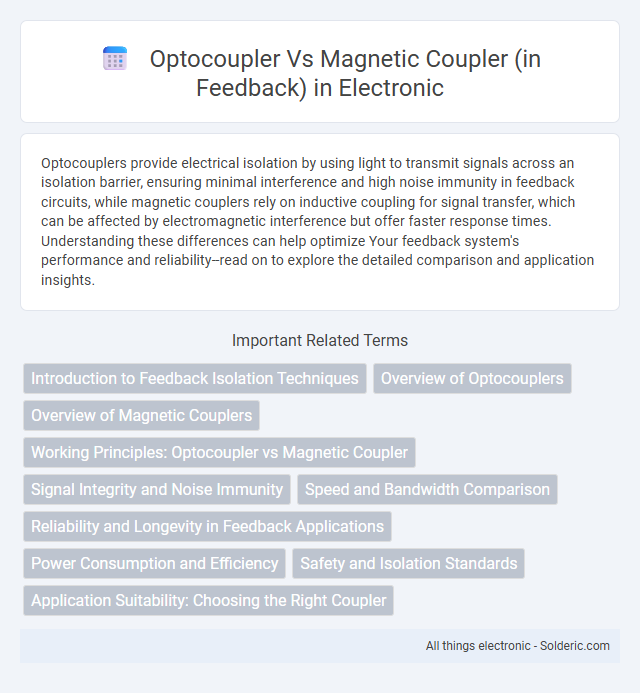Optocouplers provide electrical isolation by using light to transmit signals across an isolation barrier, ensuring minimal interference and high noise immunity in feedback circuits, while magnetic couplers rely on inductive coupling for signal transfer, which can be affected by electromagnetic interference but offer faster response times. Understanding these differences can help optimize Your feedback system's performance and reliability--read on to explore the detailed comparison and application insights.
Comparison Table
| Feature | Optocoupler | Magnetic Coupler |
|---|---|---|
| Coupling Method | Light (LED and phototransistor) | Magnetic field (inductive coupling) |
| Isolation Voltage | Typically 5kV to 10kV | Varies, up to several kVs depending on design |
| Frequency Response | Up to a few hundred kHz | Up to several MHz (better high-frequency response) |
| Linearity | Limited, non-linear response | Better linearity for feedback control |
| Size & Integration | Compact, easy to integrate | Typically larger coil structures |
| Temperature Stability | Moderate, affected by LED aging | High, less affected by temperature variations |
| Signal Delay | Higher delay due to LED-phototransistor response | Lower delay, faster feedback |
| Cost | Generally low cost | Higher cost due to coil and magnetic materials |
| Application in Feedback | Common in low-frequency isolated feedback | Preferred for high-speed, precise feedback control |
Introduction to Feedback Isolation Techniques
Feedback isolation techniques use optocouplers and magnetic couplers to prevent electrical noise and interference between circuit sections while maintaining signal integrity. Optocouplers provide galvanic isolation through light signals, ensuring high voltage separation and low noise susceptibility, making them ideal for precise digital feedback in switching power supplies. Magnetic couplers rely on transformers or inductive coupling, offering robustness in high-frequency applications and enabling efficient analog feedback transfer without direct electrical connection.
Overview of Optocouplers
Optocouplers, also known as optoisolators, provide electrical isolation by transferring signals through light, which prevents high voltages from damaging sensitive components in your feedback circuits. They offer high noise immunity and fast response times compared to magnetic couplers, making them ideal for precise signal transmission in power supplies and microcontroller interfaces. The semiconductor-based design ensures compact size and durability, enhancing system reliability in various electronic applications.
Overview of Magnetic Couplers
Magnetic couplers in feedback systems transfer signals through magnetic fields, providing galvanic isolation without electrical contact, making them highly reliable for noise immunity and signal integrity. Unlike optocouplers, which rely on light transmission, magnetic couplers excel in high-frequency applications and environments with extreme temperatures or radiation. Your choice of magnetic couplers improves durability and reduces signal degradation in industrial and medical feedback control systems.
Working Principles: Optocoupler vs Magnetic Coupler
Optocouplers use light emitted by an LED to transmit signals across an isolation barrier, converting electrical input signals into optical signals and back to electrical output without direct electrical contact, ensuring high noise immunity and galvanic isolation. Magnetic couplers transfer feedback signals through magnetic fields generated by coils, enabling signal transmission without electrical connection, but may be more susceptible to electromagnetic interference and require careful coil alignment. Your choice depends on the need for signal integrity, isolation level, and sensitivity to environmental noise in feedback applications.
Signal Integrity and Noise Immunity
Optocouplers offer excellent noise immunity due to their galvanic isolation and ability to block electromagnetic interference, preserving signal integrity in sensitive electronic feedback applications. Magnetic couplers, while providing isolation through magnetic fields, are more susceptible to external magnetic noise and signal distortion, potentially compromising feedback accuracy. For high-fidelity signal transfer in noisy environments, optocouplers generally outperform magnetic couplers in maintaining signal clarity and stability.
Speed and Bandwidth Comparison
Optocouplers typically have slower response times and limited bandwidth, often in the range of a few hundred kilohertz, due to the inherent delay in LED-phototransistor light transmission. Magnetic couplers, using transformer or inductive coupling principles, offer significantly higher speed and bandwidth capabilities, often reaching several megahertz or more, making them suitable for high-frequency feedback applications. The choice between optocouplers and magnetic couplers depends on the required signal speed and frequency range within the feedback loop design.
Reliability and Longevity in Feedback Applications
Optocouplers offer high reliability in feedback applications due to their electrical isolation and immunity to electromagnetic interference, resulting in longer operational life under harsh conditions. Magnetic couplers provide robust performance with minimal wear since they involve no physical contact, enhancing longevity in environments with mechanical stress. Choosing the right component depends on your system's specific demands for stability, noise resistance, and lifecycle requirements.
Power Consumption and Efficiency
Optocouplers typically consume less power due to their ability to isolate signals using light, resulting in lower energy loss and high efficiency in low-power feedback circuits. Magnetic couplers, while offering robust isolation and noise immunity, generally exhibit higher power consumption because of core losses and eddy currents in the magnetic materials. For Your designs prioritizing energy efficiency, optocouplers often provide superior performance in minimizing power usage during feedback signal transmission.
Safety and Isolation Standards
Optocouplers provide high electrical isolation with isolation voltages typically ranging from 3kV to 7kV, meeting stringent safety standards such as IEC 60747-5-5 and UL1577, ensuring reliable protection against high-voltage surges. Magnetic couplers, while offering galvanic isolation, generally achieve lower isolation voltages and may require additional shielding to comply with the same safety certifications. Your choice depends on the required isolation level and compliance with industry-specific standards to ensure optimal safety in feedback circuit applications.
Application Suitability: Choosing the Right Coupler
Optocouplers excel in applications requiring electrical isolation and noise immunity, making them ideal for signal feedback in sensitive electronic circuits. Magnetic couplers, such as transformers, are better suited for power transfer and high-frequency feedback due to their efficiency and robustness. Your choice between optocouplers and magnetic couplers should consider the specific isolation requirements, frequency range, and environmental conditions of your application to ensure optimal performance.
optocoupler vs magnetic coupler (in feedback) Infographic

 solderic.com
solderic.com